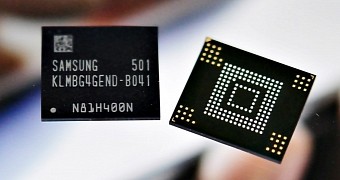There is always some new advancement ready to set off, and Samsung is particularly interested in DRAM memory and NAND Flash storage. Both types of memory have now been combined in one single whole.
In its latest press release, Samsung revealed that it had finally completed the world's first embedded package on package memory chip.
This chip offers 3 GB of LPDDR3 DRAM, which is almost as much as a DIMM memory module for PCs. More importantly, it also integrates NAND Flash memory, 32 GB to be specific. The NAND Flash capacity is of the eMMC variety (embedded multi-media card).
The implications of ePoP memory
Random access memory and storage memory have been combined in a single package, which effectively reduces not only the space needed in a device but also the power requirements.
DRAM and NAND are already quite energy-efficient to begin with. Making it so that they only need a single die to be powered adds to that.
More importantly, the ePoP is thin enough to stack directly on top of whatever mobile processor your smartphone, tablet or other mobile device happens to use.
The I/O data transfer rate of the DRAM part is of 1,866 Mbps, or 1,866 MHz, and is done over an input/output bandwidth of 64 bits.
Space-wise, the chip only occupies an area of 15 mm x 15 mm, which means 225 square millimeters. Stacking it on top of the main CPU essentially eliminates the footprint altogether.
That means that the room that would otherwise have had to be allocated to memory and storage can be given to a second battery pack, or some extra technology or other.
For perspective, a separate processor and DRAM chip, plus an eMMC card, would need 374.5 square millimeters for themselves otherwise.
Practical applications
The new ePoP memory device from Samsung can very effectively meet the needs of wearable electronic devices (smartwatches, smartbands, eyewear) and will surely enable better smartphones, although they might work against thinner form factors, to a small extent.
The ball is now in the court of global mobile companies and carriers, which have the final say on what portable devices are made and how. No doubt Samsung itself is already using them extensively. We won't be surprised if the Mobile World Congress trade show in March hosts the launch of some new products based on the technology.

 14 DAY TRIAL //
14 DAY TRIAL //